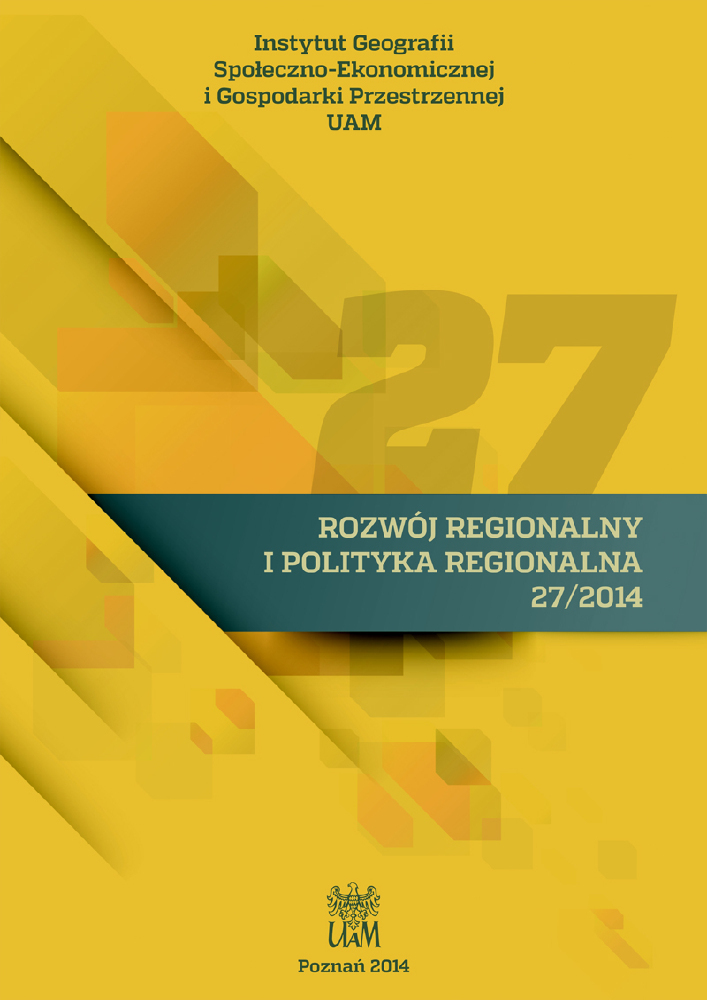Abstract
Abstract: The aim of the analysis is to assess the size and structure of investments financed from EU funds raised by the local authorities of Poznan in the context of the needs and the accuracy of the identified areas of polarization development in Poland. The analysis refers to the first two financial perspectives of the European Union – 2004–2006 and 2007–2013 – in which Poland participated as a member state, including the first decade of our experience in the implementation of EU policies. The results identified for Poznan refers to the comparative analysis of the five largest Polish cities: Warsaw, Krakow, Lodz, Wroclaw and Gdansk.References
Barca F. 2009. An Agenda for a Reformed Cohesion Policy. A place-based approach to meeting European Union challenges and expectations. Independent Report.
Barca. F., McCann P., Rodriguez-Pose A. 201. The case for regional development intervention: place-based versus place-neutral approaches. Journal of Regional Science, 52, 1: 134–152. DOI: https://doi.org/10.1111/j.1467-9787.2011.00756.x
Canning D., Bennathan E. 2000. The social rate of return on infrastructure investments. Policy Research Working Paper Series, 2390. World Bank, Washington DC. DOI: https://doi.org/10.1596/1813-9450-2390
Canning D., Bennathan E. 2004. The rate of return to transportation infrastructure. World Bank research project Infrastructure and Growth: A Multi-Country Panel Study (RPO 680–89), sponsored by the Public Economics Division of the Development
Research Group and by the Transport, Water and Urban Development Department.
Churski P. 2014a. The polarization-diffusion model in the changes to the cohesion policy – the consequences to the direction of the growth policy. [W:] P. Churski (red.), The social and economic growth vs. the emergence of economic growth and stagnation areas. Bogucki Wydawnictwo Naukowe, Poznań, s. 13–27.
Churski P. 2014b. Variations in the spatial distribution of areas of economic growth and stagnation in Poland: Determinants and consequences. Quaestiones Geographicae, 33(2): 63–78. DOI: https://doi.org/10.2478/quageo-2014-0016
Churski P., Borowczak A., Dolata M., Dominiak J., Hauke J., Perdał R., Konecka-Szydłowska B. 2012. Identyfikacja obszarów wzrostu i obszarów stagnacji gospodarczej w Polsce na poziomie regionalnym i subregionalnym. Raport II. Wyniki projektu badawczego Narodowego Centrum Nauki NN 306 79 19 40: Rozwój społeczno-gospodarczy a kształtowanie się obszarów wzrostu i obszarów stagnacji gospodarczej. Zakład Analizy Regionalnej, IGSEiGP UAM, Poznań.
Churski P., Borowczak A., Dolata M., Dominiak J., Hauke J., Perdał R., Konecka-Szydłowska B. 2013. Analiza procesu rozwoju obszarów wzrostu i obszarów stagnacji gospodarczej w Polsce na poziomie regionalnym i subregionalnym. Raport III. Wyniki projektu badawczego Narodowego Centrum Nauki NN 306 79 19 40: Rozwój społeczno-gospodarczy a kształtowanie się obszarów wzrostu i obszarów stagnacji gospodarczej. Zakład Analizy Regionalnej, IGSEiGP UAM, Poznań
.
Crafts N. 2009. Transport infrastructure investment: Implications for growth and productivity. Oxford Review of Economic Policy, 25(3): 327–343. DOI: https://doi.org/10.1093/oxrep/grp021
Faludi A. 2006. From European Spatial Development to Territorial Cohesion Policy. Regional Studies, 40, 6: 667–678. DOI: https://doi.org/10.1080/00343400600868937
Growing unequal?: Income Distribution and Poverty in OECD Countries, OECD Report 2008. Paris.
Kessides C. 1993. The Contributions of Infrastructure to Economic Development: a Review of Experience and Policy Implications. World Bank, Washington DC. DOI: https://doi.org/10.1596/0-8213-2628-7
Molle W. 2007. European Cohesion Policy. Routledge, London. DOI: https://doi.org/10.4324/9780203945278
Ósme sprawozdanie z postępów w dziedzinie spójności gospodarczej, społecznej i terytorialnej. Sprawozdanie Komisji dla Parlamentu Europejskiego i Rady. Regionalny i miejski wymiar kryzysu. (SWD (2013) 232 final). COM (2013) 463 final, Bruksela, 26.6.2013.
Pakiet legislacyjny 2014–2020 (Dziennik Urzędowy UE, L347, t. 56, 20 grudnia 2013, Bruksela).
Regional Development Policies in OECD Countries. OECD Report 2010. Paris.
Reshaping Economic Geography. World Development Report 2009: November 2008. The World Bank.
Rosik P. 2005. Produktywność publicznych inwestycji infrastrukturalnych. Ruch Prawniczy, Ekonomiczny i Socjologiczny, 2: 155–171.
Sixth Report on Economic, Social and Territorial Cohesion, Investment for jobs and growth: Promoting development and good governance in EU regions and cities. Regional and Urban Policy, European Commission, July 2014, Brussels.
Wpływ członkostwa Polski w Unii Europejskiej i realizowanej polityki spójności na rozwój kraju. 2014. Krajowe Obserwatorium Terytorialne. Ministerstwo Infrastruktury i Rozwoju, Warszawa.
Założenia Krajowej Polityki Miejskiej do 2020 roku. Przyjęte przez Radę Ministrów na posiedzeniu w dniu 16 lipca 2013 r. Ministerstwo Rozwoju Regionalnego, Warszawa.
License
Copyright
© 2014 IGSEiGP, Uniwersytet im. Adama Mickiewicza w Poznaniu
OPEN ACCESS
